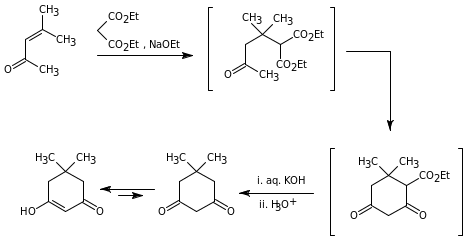Dimedone is a well known organic chemistry compound that is yellow and solid in appearance, stable but sensitive to light un-compared to other oxidizing agents. Dimedone has a molecular weight of 140.1797g/mol and has a melting point of between 147–150oC (420-423oK). Dimedone molecular formula is (CH3)2C6H6(=O)2.
This yellow crystalline substance is soluble in water and has an IUPAC name as 5,5-dimethylcyclohexane-1,3-Dione (Dimedone). Dimedone use is not limited to spectrophotometric, luminescence, colorimetric and crystallography analysis, but also used in determining aldehyde group containing compounds.
Organic chemistry is based on compounds containing carbon-carbon bonds, and therefore the formation of these bonds is fundamental to achieving the synthesis of many complex molecules. Carbanions which are stabilised by an adjacent carbonyl group are known as enolate anions. The enolate anion is a versatile intermediate in organic synthesis since it is easily formed and reacts with a variety of electrophilic carbon species to give compounds with new carbon-carbon bonds.
The ease of the enolate anion formed depends on the acidity (pKa) of the protons adjacent to the carbonyl group. A Michael addition can take place by addition of a nucleophilic enolate ion donor to the carbon of an-unsaturated carbonyl acceptor. Another important carbon-carbon bond forming reaction is the aldol condensation. A compound possessing an active methylene group may undergo base catalysed addition to a carbonyl group, followed by subsequent dehydration of the initial adduct. This general reaction is referred to as the aldol condensation after the structure of the initial adduct in the self-condensation of ethanol (acetaldehyde).
In this experiment, dimedone is synthesized using a multistep sequence that demonstrates carbon-carbon bond formation. The base catalysed conjugate addition (Michael addition) of diethyl propanedioate (diethyl malonate) to 4-methylpent-3-en-2-one (mesityl oxide) yields an intermediate which undergoes concomitant intramolecular aldol condensation under the reaction conditions.
The cyclised material, on hydrolysis and acidification undergoes ready decarboxylation to furnish 5,5-dimethylcyclohexane-1,3-dione which exists as a mixture of its keto and enol tautomers.
The standard free energy(SFE) schemes make clear the forecasting concerning the keto-enol equilibrium arrangement. Enol tautomer will be favored when the SFE is < than 0. While on the other hand, when SFE is > than 0 keto tautomer will be favored. The standard free energy can also be applied to further study the systems entropy and enthalpy standardizations. During NMR spectra analysis, the systems temperature varies. When the mean kinetic energy increases, the overall keto tautomer also rises due to lack of stable hydrogen bond within its molecules (Alexanderm, 2005). The nuclear magnetic resonance spectra aids in the relative amount determination of different hydrogen atoms found within the keto- enol equilibrium state. Various techniques can be employed in the determination of hydrogen proportion on the keto, enol tautomer relationship.i.e. the α– proton location of every tautomer can exist in a proportion that facilitate the calculation of the constant (K) value within an exacting system.
The rate at which the standard free energy and their respective tautomers are converted and the characteristics of their physical conditions influence the NMR output, hence influencing the equilibrium outcome of the analysis. If the conversion proportion between tautomers is of a slow nature ( thought slow, but can arrive at an equilibrium state) might mean that the primary keto dilutions contain added keto tautomer. Nevertheless, when the interconversion state is extremely slow, hence more energy required to finish the conversion course. Due to exemplary energy needs, one tautomer might be favored than the other. Generally, NMR spectroscopy is a suitable, time-saving, fitting and exceptional technique for establishing keto-enol equilibria. A great deal of information can be obtained from an NMR spectrum with minute obstruction from inaccuracy. Using a temperature controlled NMR spectrometer might go long way in improving the quality of the obtained data.
References
Abby, P., 1999. Department of Chemistry University of Memphis. Web.
Alexanderm, T. 2005. Thermodynamics of a Keto-Enol Equilibrium. Web.
Chang Bioscience, 2002 – 2004, Beer Lambert Calculator. Web.
Clayden,J., Greeves, N., Warren, S. and Wothers, P. 2000. Organic Chemistry (1st ed.). Oxford University Press. p. 532
Silverstein R. M. & Webster F.X., 1998 Spectrometric Identification Organic Compounds, 6th ed., Wiley, New York.
University of Calgary Faculty of science department of chemistry, 2010, Chem 353 homepage Organic chemistry. Web.
Appendix
Scheme 1
